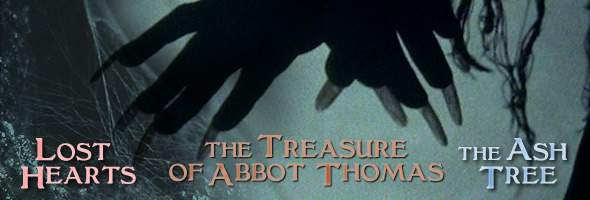
LOST HEARTS
Color, 1973, 35m.
Directed by Lawrence Gordon Clark
Starring Simon Gipps-Kent, Joseph O'Conor, Susan Richards, James Mellor, Roger Milner
THE TREASURE OF ABBOT THOMAS
Color, 1974, 40m.
Directed by Lawrence Gordon Clark
Starring Michael Bryant, Paul Lavers, Sheila Dunn, Anne Blake, Frank Mills
THE ASH TREE
Color, 1975, 35m.
Directed by Lawrence Gordon Clark
Starring Edward Petherbridge, Preston Lockwood, Barbara Ewing, Lalla Ward
BFI (DVD) (UK R2 PAL), Shock (Australia R0 PAL)
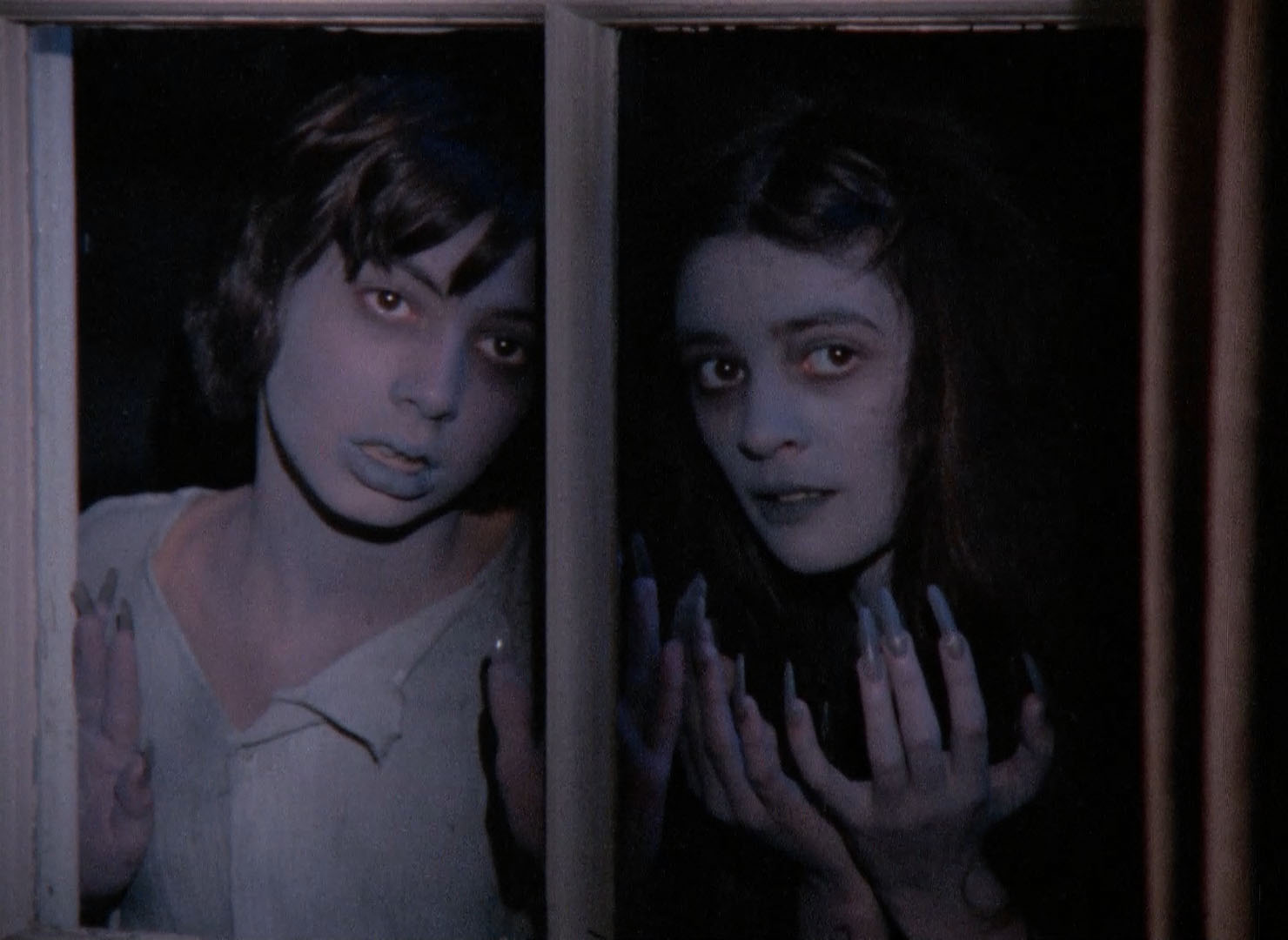 After captivating viewers with its atmospheric M.R. James adaptations like "Whistle and I'll Come to You" and a pair of classics directed by Lawrence Gordon Clark, the BBC's "Ghost Story for Christmas" tradition was firmly entrenched by 1973. The low-budget yearly broadcasts proved to be the perfect recipe for elegant chills in the dead of winter, with the famous ghost story's works turned into the modern equivalent of campfire tales set in remote English manors and long-buried dens of supernatural malevolence.
After captivating viewers with its atmospheric M.R. James adaptations like "Whistle and I'll Come to You" and a pair of classics directed by Lawrence Gordon Clark, the BBC's "Ghost Story for Christmas" tradition was firmly entrenched by 1973. The low-budget yearly broadcasts proved to be the perfect recipe for elegant chills in the dead of winter, with the famous ghost story's works turned into the modern equivalent of campfire tales set in remote English manors and long-buried dens of supernatural malevolence.
The third official film in the series, "Lost Hearts," is in many ways the creepiest of them all. The story involves a young orphan named Stephen (The Tomorrow People's Gipps-Kent) who goes to stay with his mysterious and very odd Uncle Abney (Gorgo's O'Conor), a suspiciously friendly alchemist who has an intense fascination with keeping track of the boy's age. Stephen hears stories about two children, a gypsy boy and a young girl, who died on the property years before, and one night the two of them -- complete with blue skin and long, sharp fingernails -- begin prowling the house and lurking in his room, accompanied by off-kilter hurdy gurdy music. Oh, and their hearts have been ripped from their chests.
An unnerving predecessor to the vampire kids in Salem's Lot with a dash of Werner Herzog-style artiness thrown in, this is one of the shortest and tightest of the yuletide ghost stories, and it's structured a bit differently as the real horror moments lie in the middle of the story rather than the end (which closes on an ironic and strangely whimsical note instead). It's not an all-out terror fest, of course, but the sight of those two undead kids smiling as they bob up and down the hallways is not easily forgotten. Inexplicably absent from home video for decades, this made its debut first in Australia as part of an M.R. Jam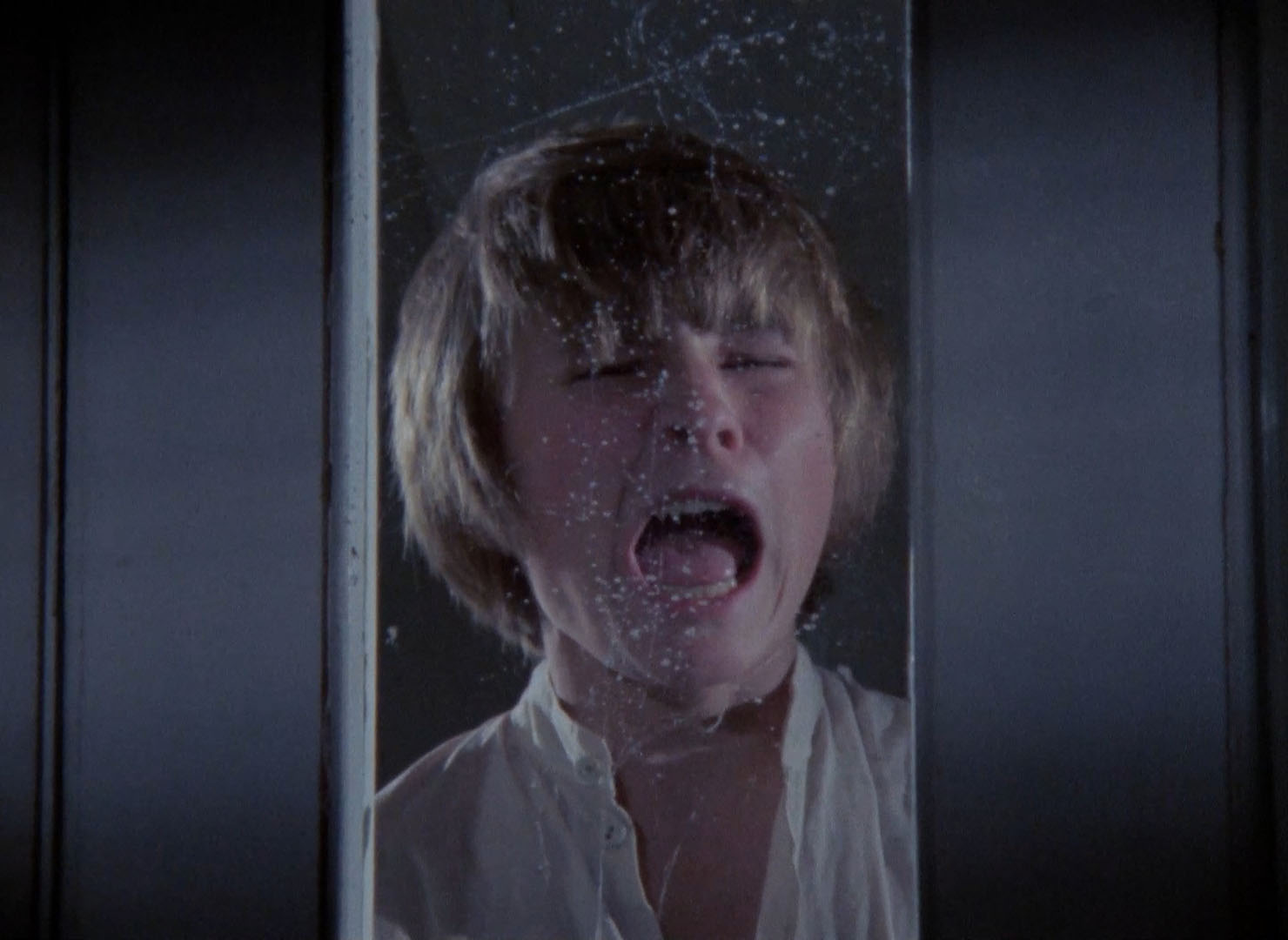 es boxed set and shortly after from the BFI in a special edition, with both versions attaching it to the same two other BBC productions. Taken from what's probably the only master available from the BBC, the BFI disc looks very solid for a cheap 16mm production from the early '70s; the Australian one used the same source but, as was the case with all of the BBC vs. Shock releases, the UK one boasts more careful compression and gives the films a little more breathing room. The all-important blue hues of the night scenes look especially eerie here, and apart from a little print damage that's been printed in since this was broadcast, all seems to be well here.
es boxed set and shortly after from the BFI in a special edition, with both versions attaching it to the same two other BBC productions. Taken from what's probably the only master available from the BBC, the BFI disc looks very solid for a cheap 16mm production from the early '70s; the Australian one used the same source but, as was the case with all of the BBC vs. Shock releases, the UK one boasts more careful compression and gives the films a little more breathing room. The all-important blue hues of the night scenes look especially eerie here, and apart from a little print damage that's been printed in since this was broadcast, all seems to be well here.
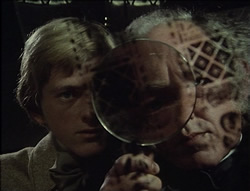 The following year's entry, "The Treasure of Abbot Thomas" from 1974, feels like something of a cousin to "The Stalls of Barchester" as it involves a treasure hunt inside an old church (of course). Reverend Somerton (The Stone Tape's Bryant) enjoys debunking the supernatural, even when it comes to seances held by the mother of one of his friends, Lord Peter (TV presenter Lavers, a dead ringer for Shane Briant). The Reverend would much rather spend his time hunting for the legendary treasure of mysterious alchemist Abbot Thomas, which has been hidden somewhere on the monastery grounds on which Somerton now resides. After much deciphering of Latin and breaking of codes, Somerton, with the aid of Lord Peter, finally finds his way to an underground catacomb where a strange black slime seems to emanate from the treasure's location. But that's just the beginning of the horrors waiting in store for him...
The following year's entry, "The Treasure of Abbot Thomas" from 1974, feels like something of a cousin to "The Stalls of Barchester" as it involves a treasure hunt inside an old church (of course). Reverend Somerton (The Stone Tape's Bryant) enjoys debunking the supernatural, even when it comes to seances held by the mother of one of his friends, Lord Peter (TV presenter Lavers, a dead ringer for Shane Briant). The Reverend would much rather spend his time hunting for the legendary treasure of mysterious alchemist Abbot Thomas, which has been hidden somewhere on the monastery grounds on which Somerton now resides. After much deciphering of Latin and breaking of codes, Somerton, with the aid of Lord Peter, finally finds his way to an underground catacomb where a strange black slime seems to emanate from the treasure's location. But that's just the beginning of the horrors waiting in store for him...
Sort of a Jamesian spin on the code-breaking games of Poe's "The Gold Bug" but with a supernatural sting in its tail, this one is more of a medieval-tinged puzzle as the two men try to piece together the mystery of the missing treasure. The swerve into full-on gothic terror in the final stretch climaxes with a great shock sequence in the catacombs and an eerie little coda, coupled with a chilling choir-augmented score. Fine stuff all around, this wouldn't be the best title for newcomers to jump into first -- but 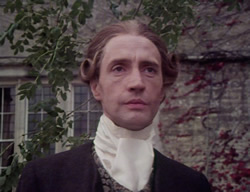 it's definitely worth viewing. Also never granted an official video release until its pairing with "Lost Hearts," this one also looks substantially better than the dupey TV airings copied and swapped by collectors for years and, for a scrappy 16mm show, fares admirably in the digital age within its limitations.
it's definitely worth viewing. Also never granted an official video release until its pairing with "Lost Hearts," this one also looks substantially better than the dupey TV airings copied and swapped by collectors for years and, for a scrappy 16mm show, fares admirably in the digital age within its limitations.
The disc closes out with the last of Clark's James tales for the BBC, "The Ash Tree." It's easily the most obscure of the bunch as it rarely reappeared on TV, but the nightmarish finale left a major impression on some lucky viewers as it involved a rampaging horde of... well, let's just say fans of "The Zanti Misfits" from The Outer Limits will find an even more grotesque variation on that idea here. The always excellent Edward Petherbridge (who later went on to play Lord Peter Wimsey in a great trio of '80s UK TV mysteries) carries the show here as Sir Richard, a layabout who inherits the estate of his late uncle. Unfortunately, upon arrival he's haunted by dreams of his witch-hunting ancestor, Sir Matthew (Petherbridge again), whose bloodline was cursed by a hanged sorceress. Soon animals start dropping dead on the property, and the huge, seemingly impenetrable ash tree outside his window seems to play a larger role in the supernatural history of the house than anyone's letting on. This one's really all about the final five minutes, a dark, scary, fiery finale that probably sent the majority of its viewers rushing to flip on the lights after the credits rolled. Seeing so overtly monstrous and horrific in a James adaptation is still a bit surprising, and Clark wisely keeps things dim and shadowy enough to pack a punch within the confines of that familiar film stock.
The BFI release (which also appears in a Halloween-timed set of five discs with the rest of the BBC ghost stories) comes with individual video intros for each story, with Clark reminiscing between eight to ten minutes apiece about how each short story was chosen and how he continued to maneuver around the network's perception of him as a documentarian. Some of the more important points include the switch to using a different screenwriter than himself for the first time and his insistence on using storyboards, but the best segment is easily the one for "The Ash Tree." He rattles off some great stories about how the production team couldn't find a suitable house with an ash tree in front of it (so they used reverse shots of the ash tree outside his own home thirty miles away from the main filming location) and how one of the monstrous beasties from the finale remained stuck in that tree long afterwards, much to the distress of passersby. The liner notes booklet includes an essay by the great Ramsey Campbell for "Lost Hearts" (in which he points out a few salient observations about changes to the story and the evocative use of fog), an Alex Davidson essay for "The Treasure of Abbott Thomas" (who considers several of the changes to the original text to be improvements), and Dick Fiddy's take on "The Ash Tree" (focusing on the script by playwright David Rudkin and the palpable sense of doom created by the performances). On top of that you get bios for James and Clark, an additional recap essay on all three by actor/writer Robert Lloyd Parry focusing strictly on their literary angle, and even a sample Abbott Thomas storyboard. Truly spooky, truly wonderful.
Updated review on August 24, 2012.





